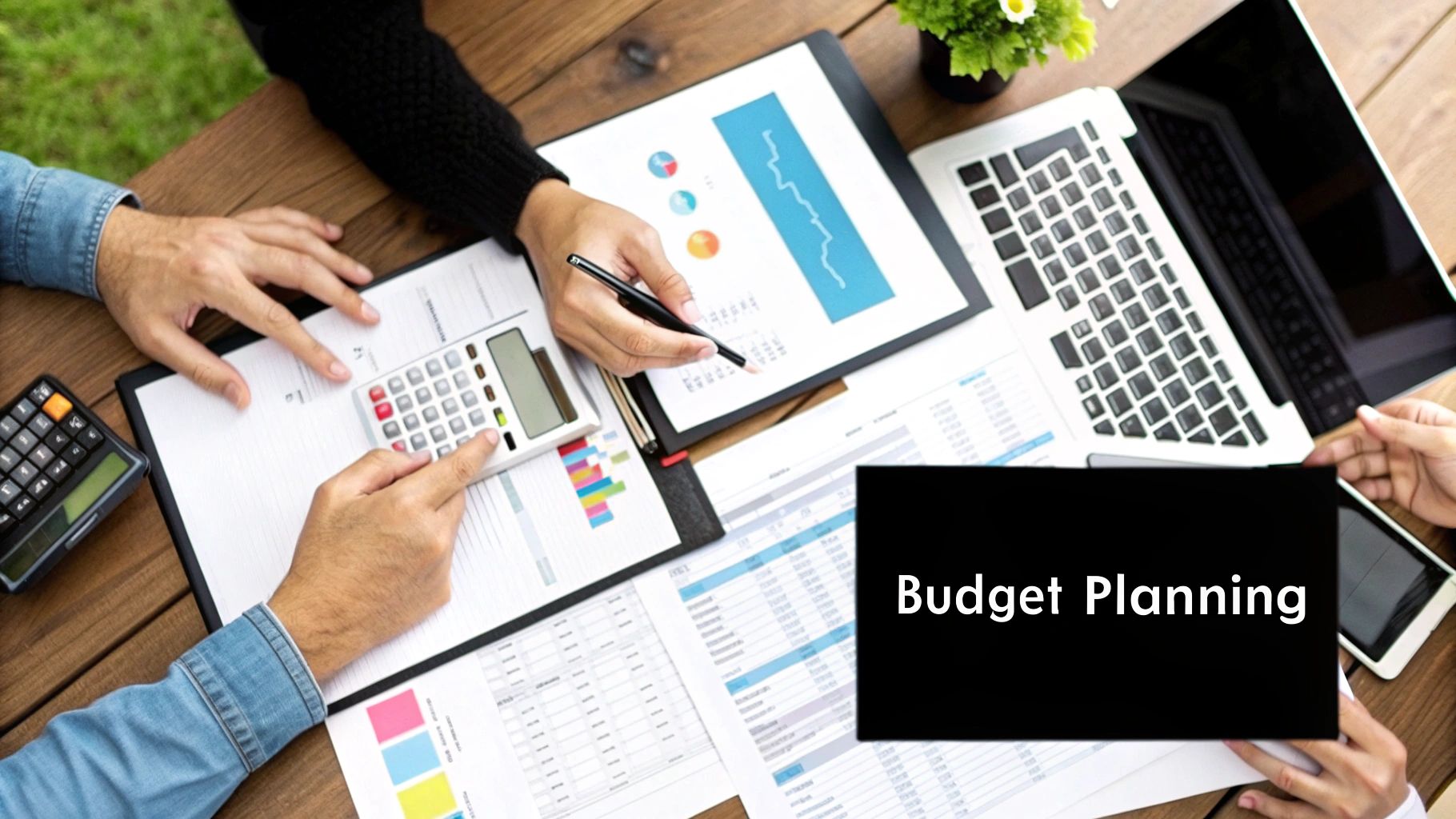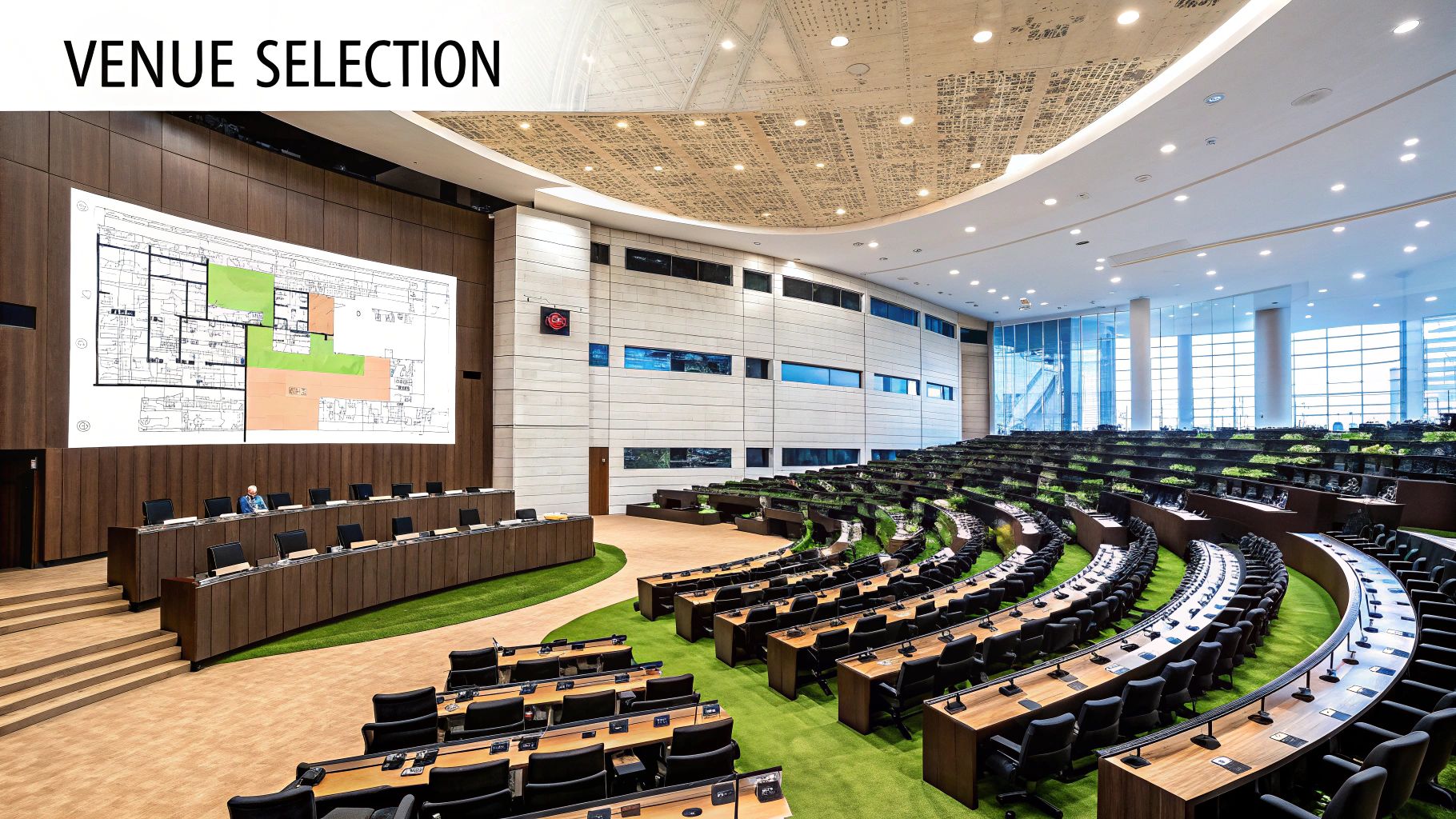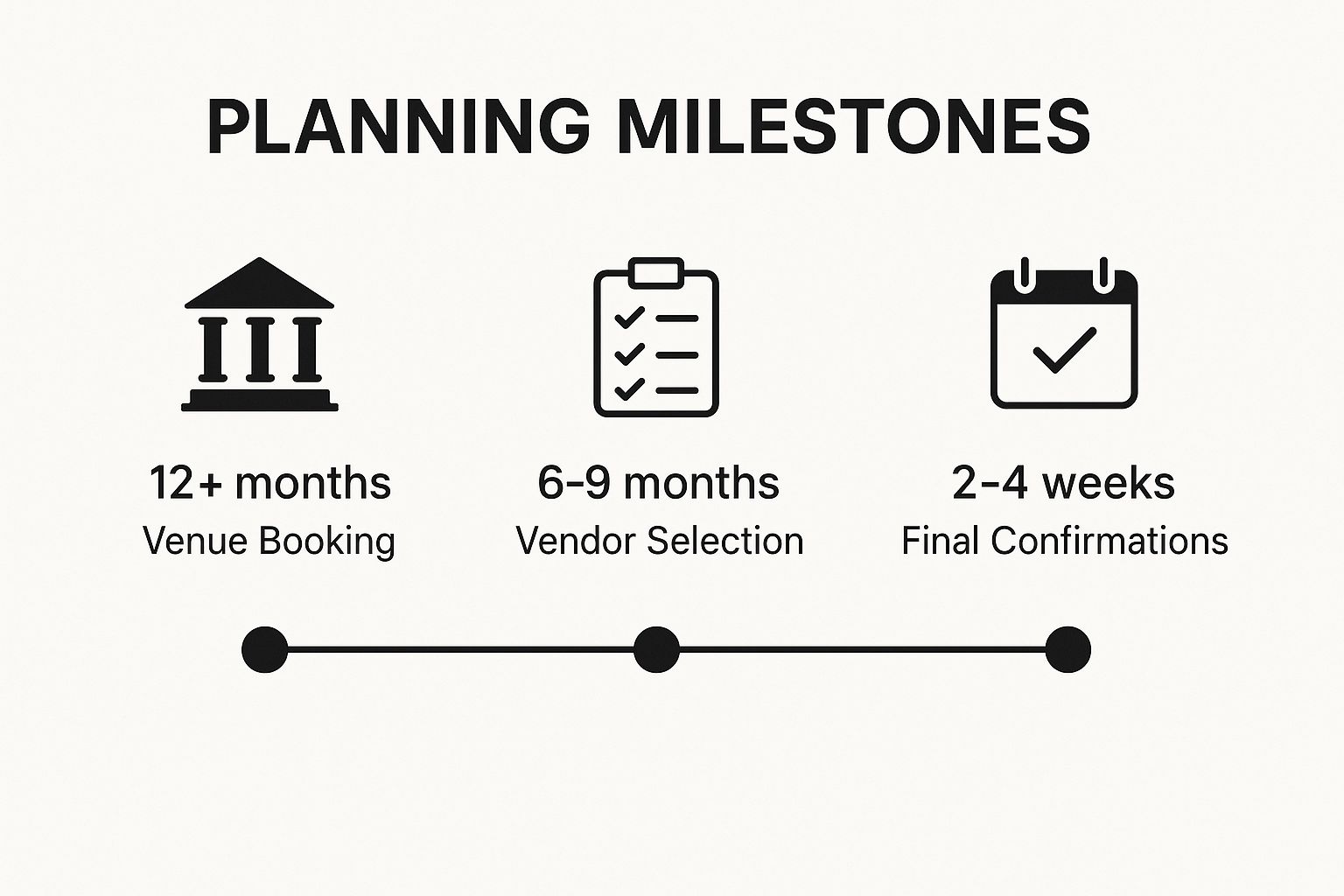Ultimate Corporate Event Planning Checklist for Success
- Chase Gillmore

- May 10
- 16 min read
Setting the Stage for Success
Planning a successful corporate event requires a structured approach. This corporate event planning checklist provides a roadmap for navigating the complexities of event organization in 2025, ensuring a memorable and impactful experience. From budget management and venue selection to attendee experience design and technology integration, this checklist covers seven essential steps. Whether it's a conference, product launch, or gala, this guide will empower you to create an exceptional event that achieves its objectives. Following these steps will help you stay organized, manage resources effectively, and ultimately, deliver a successful event.
1. Budget Planning and Management
Budget planning and management is the cornerstone of any successful corporate event. This crucial first step in your corporate event planning checklist involves creating a comprehensive financial framework that outlines all anticipated expenses. It acts as a roadmap, guiding your decision-making throughout the entire planning process, from choosing a venue to selecting the perfect floral arrangements. Effective budget planning ensures you can deliver a memorable event without encountering unexpected financial hurdles. This involves forecasting costs for everything from the venue and catering to entertainment, technology, marketing materials, transportation, accommodations, and, importantly, a contingency fund.

A well-structured budget includes a detailed line-item breakdown of all anticipated costs, enabling you to track spending effectively. It incorporates mechanisms for monitoring expenses against the budget, vendor payment schedules, and metrics for measuring return on investment (ROI). Crucially, a robust budget always includes a contingency allocation – typically 10-15% of the total budget – to cover unforeseen expenses and ensure financial flexibility. This foundational element of corporate event planning deserves its place at the top of the checklist because it directly influences every subsequent decision and contributes significantly to the event's overall success.
Features of Effective Budget Planning:
Line-item breakdown: Detailed categorization of all expected costs.
Budget tracking mechanisms: Tools and processes for monitoring expenditures.
Vendor payment schedules: Clearly defined payment terms for all vendors.
ROI measurement metrics: Methods for evaluating the event's financial success.
Contingency allocations: A financial buffer for unexpected costs (10-15%).
Pros:
Prevents unexpected financial shortfalls: Proactive planning avoids cost overruns.
Facilitates strategic decision-making: Informed choices based on available resources.
Helps justify expenses to stakeholders: Transparent budgeting builds trust and accountability.
Provides historical data for future events: Valuable insights for refining future budgets.
Cons:
Can be time-consuming to create comprehensive budgets: Requires detailed research and planning.
Requires ongoing adjustments as variables change: Flexibility is key to adapt to evolving needs.
May limit creative possibilities if too restrictive: Finding a balance between budgetary constraints and creative vision is crucial.
Examples of Successful Implementation:
Salesforce's Dreamforce conference: Utilizes a multi-tiered budgeting approach with separate allocations for different event components, allowing for granular control and analysis.
Google I/O: Implements zero-based budgeting, requiring justification for each expense category annually, ensuring efficient resource allocation.
Tips for Effective Budget Planning:
Use specialized event budgeting software: Explore tools like Planning Pod or Eventbrite to streamline the process.
Review past event budgets for benchmarking: Leverage historical data to inform current planning.
Build in a minimum 10% contingency fund: Prepare for unexpected expenses and maintain flexibility.
Get multiple vendor quotes for major expenses: Compare pricing and services to secure the best value.
Create budget scenarios: Develop best-case, expected-case, and worst-case scenarios to anticipate potential financial outcomes.
Popularized By:
Event planning methodologies from the Project Management Institute (PMI) and financial planning frameworks from the Event Leadership Institute have contributed significantly to the development of best practices in event budget management. By adhering to these principles, event planners can effectively manage resources and ensure the financial success of their events.
2. Venue Selection and Management
Venue selection and management is a crucial step in any corporate event planning checklist. It's the process of identifying, evaluating, and securing the perfect location for your event, impacting everything from attendee experience to budget management. This involves carefully considering factors like space requirements, accessibility, technical capabilities, and how well the venue aligns with your event's objectives and overall brand identity. Effective venue management also extends to coordinating with the facility staff before, during, and even after the event to ensure everything runs smoothly.

This item deserves a prominent place on the corporate event planning checklist because the venue sets the tone and atmosphere for the entire event. Think of it as the stage for your corporate narrative. A strategically chosen venue can significantly elevate attendee experience and satisfaction, while a poor choice can derail even the most meticulously planned program. For example, Apple strategically chooses minimalist, modern venues for their product launches, reinforcing their brand identity of sleek innovation. Conversely, large-scale conferences like Microsoft's Build utilize expansive convention centers with multiple breakout rooms to accommodate diverse sessions and networking opportunities. Learn more about Venue Selection and Management
Features like capacity assessment tools, floor plan design capabilities, AV and technical infrastructure evaluations, accessibility compliance checks, and clear contract negotiation protocols are essential components of effective venue selection and management. These tools allow planners to make informed decisions and anticipate potential challenges.
Pros:
Sets the Tone and Atmosphere: The venue significantly influences the overall feel of your event.
Impacts Attendee Experience: A well-chosen venue contributes to a positive and memorable attendee experience.
Strategic Location Choices Can Increase Attendance: Convenient and accessible locations can boost participation.
All-inclusive Venues Can Simplify Planning: Some venues offer packaged services that streamline the planning process.
Cons:
Premium Venues Often Require Advanced Booking: Popular venues, especially for peak seasons, often require bookings 12-18 months in advance.
Hidden Costs Can Impact Budgets: Be wary of unexpected costs such as service charges, security fees, and equipment rentals.
Venue Restrictions May Limit Options: Some venues may have restrictions on catering, décor, or the use of specific technologies.
Actionable Tips for Successful Venue Selection and Management:
Create a Weighted Evaluation Matrix: Prioritize your needs by assigning weights to different venue criteria.
Visit Venues in Person: Experience the space firsthand, ideally during the same time of day as your planned event.
Negotiate Flexible Attrition Clauses: Protect your budget by negotiating clauses that allow for adjustments in attendance numbers.
Request a Dedicated On-Site Coordinator: Having a point of contact at the venue can simplify logistics and address issues quickly.
Thoroughly Review Insurance Requirements and Liability Clauses: Ensure you understand the venue's insurance policies and your responsibilities.
When planning a corporate event, venue selection and management is a critical process that should begin early. By carefully considering your needs, evaluating potential venues, and implementing these tips, you can create a memorable and successful event. This applies whether you are organizing a small corporate meeting, a large-scale conference, or a celebratory gala.
3. Timeline and Project Management
A crucial element of any successful corporate event planning checklist is a robust timeline and project management strategy. This involves creating a structured scheduling framework that maps out all pre-event, day-of, and post-event tasks, assigning clear deadlines and designating responsible parties. Effective timeline management ensures that all elements of the event planning process are coordinated and completed in the proper sequence, preventing last-minute rushes or overlooked details. This proactive approach is essential for minimizing stress and maximizing the impact of your event.

The infographic above visualizes a sample event planning timeline, highlighting key milestones and deliverables. It demonstrates how breaking down the planning process into manageable phases, from initial concept and budgeting to post-event analysis, helps ensure a smooth and successful event. Notice how the timeline progresses through distinct phases, each with its own set of tasks and deadlines, ultimately culminating in the event itself and the subsequent follow-up activities.
Features of effective timeline and project management include critical path identification, milestone tracking, task dependencies mapping, resource allocation planning, and automated reminder systems. These features allow you to maintain clear visibility into the project status, identify and resolve bottlenecks early on, facilitate effective team coordination, and reduce stress through proactive planning. Speaking of planning, a comprehensive event planning checklist template can streamline your workflow and ensure you don't miss any critical steps. For a variety of helpful templates, check out this resource: Top Event Planning Checklist Template Picks from 1021 Events.
While the benefits are significant, there are also some potential drawbacks. Maintaining and updating the timeline requires ongoing effort, and for larger events, the project plan can become quite complex. Specialized project management software and training may also be necessary.
Examples of Successful Implementation:
CES (Consumer Electronics Show): Utilizes a rolling 18-month planning timeline with specific phase gates.
TED Conferences: Implements a "backward planning" methodology, starting with the event date and working backward to determine deadlines for each task.
Tips for Effective Timeline and Project Management:
Use specialized event project management tools: Asana, Trello, or Monday.com are excellent options.
Build in buffer time: Unexpected delays are inevitable, so incorporate buffer time into your schedule.
Conduct weekly status meetings: Standardized reporting ensures everyone stays informed and accountable.
Create RACI charts: Clarify roles and responsibilities for key deliverables (Responsible, Accountable, Consulted, Informed).
Develop Day-of-Event running orders: Minute-by-minute timing ensures a smooth and seamless event flow.
Popularized By:
Agile event management methodologies pioneered by tech companies.
The Event Canvas framework by Ruud Janssen and Roel Frissen.
This item deserves its place in any corporate event planning checklist because a well-defined timeline and project management strategy is the backbone of a successful event. It provides the structure and organization necessary to coordinate all moving parts, manage resources effectively, and ensure that everything comes together seamlessly on the day of the event. Whether you're organizing a small corporate meeting or a large-scale conference, implementing these practices is key to achieving your event objectives and delivering a memorable experience for all attendees.
4. Vendor and Supplier Management
Vendor and supplier management is a crucial component of any successful corporate event planning checklist. It's the systematic process of selecting, contracting, coordinating, and evaluating the various third-party service providers you'll need to bring your event vision to life. This includes everything from caterers and AV companies to decorators, photographers, transportation services, and even entertainment providers like live bands for karaoke or high-energy performances. Effective vendor management ensures that every piece of your event puzzle fits together seamlessly.
This aspect of planning is essential because it directly impacts the quality, execution, and overall success of your event. Imagine meticulously planning every detail, only to have the catering fall through or the AV equipment malfunction. A robust vendor management process mitigates these risks.
How it Works:
Vendor and supplier management involves several key stages:
Identification & Qualification: Determine the specific services you need and establish criteria for selecting qualified vendors. This might include experience, reputation, pricing, and availability.
Request for Proposals (RFPs): Use RFP templates to solicit proposals from potential vendors, ensuring a standardized comparison process.
Contract Negotiation & Service Level Agreements (SLAs): Once a vendor is selected, negotiate contracts that clearly outline services, deliverables, timelines, and payment terms. SLAs further define specific performance expectations.
Coordination & Communication: Maintain consistent communication throughout the planning process, using a centralized communication platform to keep everyone informed and aligned. Regular meetings, especially as the event approaches, are highly recommended.
Performance Evaluation: After the event, evaluate each vendor's performance based on pre-defined metrics. This provides valuable feedback for future events and helps build institutional knowledge.
Features of Effective Vendor Management:
Vendor qualification criteria: Establish clear benchmarks for evaluating potential vendors.
RFP templates: Standardized templates streamline the proposal process.
Service level agreement frameworks: Define specific performance expectations.
Performance evaluation metrics: Measure vendor success against established goals.
Vendor communication protocols: Ensure clear and consistent communication.
Pros:
Leverages specialized expertise: Benefit from the skills and experience of professionals in various fields.
Distributes workload and responsibilities: Frees up your team to focus on other critical aspects of event planning.
Provides access to exclusive resources or technologies: Vendors often have access to specialized equipment or resources.
Allows scalability for event needs: Easily adjust the scale of services based on event size and requirements.
Cons:
Requires significant coordination efforts: Managing multiple vendors can be complex.
Quality control becomes more challenging: Ensuring consistent quality across all vendors requires diligence.
Communication challenges can lead to execution errors: Miscommunication can have a ripple effect on various aspects of the event.
Examples of Successful Implementation:
Salesforce's Dreamforce maintains a preferred vendor network with pre-negotiated terms for consistent delivery.
Oracle OpenWorld implements a vendor certification program to ensure adherence to quality standards.
Actionable Tips:
Develop a comprehensive vendor management plan with clearly defined roles and expectations.
Create detailed Statements of Work (SOWs) for each vendor.
Schedule regular vendor coordination meetings as the event approaches.
Establish a central communication platform for all vendors.
Conduct post-event vendor evaluations to capture learnings and improve future events.
When and Why to Use This Approach:
Vendor and supplier management is essential for any corporate event, regardless of size or complexity. It's particularly crucial for larger events, events with multiple moving parts, and events where specialized services are required. Whether you're planning a large conference like Dreamforce, a smaller corporate gathering, or even a wedding reception, effective vendor management ensures a smooth and successful event.
Learn more about Vendor and Supplier Management
This structured approach, popularized by Strategic Meetings Management (SMM) programs in Fortune 500 companies and procurement best practices from the Global Business Travel Association (GBTA), is the cornerstone of successful corporate event planning. By dedicating time and resources to vendor management, you'll significantly increase the likelihood of a flawlessly executed and memorable event.
5. Marketing and Communication Strategy
A robust marketing and communication strategy is crucial for any successful corporate event. This element of your corporate event planning checklist encompasses all activities related to promoting your event to the target audience and maintaining seamless communication with attendees, stakeholders, and your internal team before, during, and after the event. This isn't just about sending out invitations; it's about building excitement, managing expectations, and ensuring a positive experience for everyone involved. This deserves its place on the checklist because it directly impacts attendance, engagement, and the overall perceived value of your event.
A well-defined strategy starts with understanding your target audience. Are you targeting C-suite executives, industry professionals, or the general public? This knowledge informs your messaging, channel selection, and overall communication style. Your strategy will cover everything from branding and promotional materials to digital marketing, registration systems, and ongoing communication touchpoints. Think of it as the narrative thread that connects all aspects of your event experience.
Features of a comprehensive marketing and communication strategy often include:
Integrated marketing campaign templates: Streamline your efforts with pre-built templates for various marketing channels.
Audience segmentation tools: Target specific groups with tailored messaging for maximum impact.
Multi-channel promotion frameworks: Reach your audience where they are, whether it's through email, social media, or industry publications.
Marketing analytics dashboards: Track key metrics and measure the effectiveness of your campaigns.
Branded content development workflows: Maintain consistent branding across all communications.
Pros:
Drives attendance and engagement through targeted promotion.
Builds anticipation and perceived value through compelling content.
Extends the event's impact beyond the actual date through post-event communication.
Provides data for measuring event success and informing future strategies.
Cons:
Requires significant lead time for effective execution.
Can be resource-intensive across multiple channels.
Needs consistent messaging across various platforms to avoid confusion.
Examples of Successful Implementation:
HubSpot's INBOUND conference creates year-round content marketing that builds anticipation and educates their target audience, culminating in the annual event. This long-term approach fosters a strong community and drives significant attendance.
Adobe MAX leverages user-generated content and community engagement strategies to promote attendance and create a buzz around the event. This taps into the existing enthusiasm within their user base and generates organic promotion.
Actionable Tips for Your Corporate Event:
Develop a content calendar: Schedule promotions across all channels, ensuring consistent messaging and optimal timing.
Create an event-specific website or landing page: Provide clear registration pathways and essential event information.
Utilize email marketing: Target different segments with personalized messaging, reminders, and updates.
Leverage social media: Use event-specific hashtags and engagement strategies to build community and generate buzz.
Implement an attendee communication plan: Keep attendees informed with regular updates, reminders, and post-event follow-up.
Learn more about Marketing and Communication Strategy
Popularized by event marketing frameworks from the Event Marketing Institute and digital marketing strategies from companies like Marketo and Eventbrite, a strategic approach to marketing and communication is no longer optional. Whether you’re planning a wedding reception, a corporate conference, a gala dinner, or even a private party with live band karaoke, reaching the right audience with the right message is crucial. By implementing a well-defined strategy, you can maximize attendance, create a memorable experience, and achieve your event objectives. This is particularly important for event planners, conference organizers, and even those seeking to add live music to their event, ensuring a larger and more engaged audience.
6. Attendee Experience Design
Attendee Experience Design is a crucial element of any successful corporate event planning checklist. It's a systematic approach to crafting meaningful, engaging, and seamless experiences for your event participants. This involves mapping the entire attendee journey, from the moment they register to the post-event follow-up, and designing touchpoints that align with your business objectives while simultaneously meeting participant needs and expectations. By focusing on the attendee experience, you can transform a standard event into a memorable and impactful occasion.

This approach utilizes various tools and frameworks, including journey mapping tools, experiential design frameworks, engagement metrics, personalization capabilities, and feedback collection mechanisms. These resources allow event planners to understand attendee preferences and tailor the experience accordingly. For instance, Salesforce's Dreamforce utilizes themed "campgrounds" that transform traditional expo areas into immersive experiences, boosting engagement and brand recall. Similarly, C2 Montréal implements unconventional networking formats like suspended meeting areas to facilitate unique interactions, creating a memorable experience for attendees.
Why is Attendee Experience Design essential for your corporate event planning checklist? Because it directly impacts the success of your event. A well-designed experience creates memorable brand associations, increases attendee satisfaction and retention, facilitates meaningful connections and interactions, and ultimately differentiates your event from competitors. This is particularly relevant for corporate event planners, conference organizers, and even wedding planners who want to create a lasting impression.
Tips for Effective Attendee Experience Design:
Create detailed attendee personas: Understanding your target audience is paramount. Develop detailed personas to guide your experience design decisions. Consider their demographics, professional backgrounds, interests, and expectations.
Map the complete attendee journey: Identify key moments that matter, from pre-event communication to post-event follow-up. This allows you to optimize every touchpoint for maximum impact.
Incorporate surprise and delight elements: Strategic surprises and delightful moments can elevate the attendee experience and create a buzz.
Balance structured programming with opportunities for spontaneous interaction: Provide structured sessions and activities, but also allow for informal networking and spontaneous connections.
Design with accessibility and inclusivity as foundational principles: Ensure your event is accessible and inclusive for all attendees.
Pros:
Creates memorable brand associations
Increases attendee satisfaction and retention
Facilitates meaningful connections and interactions
Differentiates your event from competitors
Cons:
Can be subjective and difficult to quantify
Requires deep understanding of audience preferences
May necessitate specialized design expertise
While attendee experience design can be subjective and require a deep understanding of your audience, the benefits significantly outweigh the challenges. By focusing on creating a truly engaging and meaningful experience, you can ensure your event achieves its objectives and leaves a lasting positive impression. Learn more about Attendee Experience Design. This approach, popularized by experience design consultancies like George P. Johnson and Freeman and drawing from design thinking methodologies adapted from IDEO and Stanford d.school, is transforming the way events are planned and executed.
7. Technology and Production Management
Technology and Production Management is a crucial element of any successful corporate event planning checklist. It encompasses the strategic planning and execution of all technical aspects, ensuring seamless content delivery and an enhanced attendee experience. This includes everything from audio-visual equipment, staging, and lighting, to more complex systems like event apps, registration platforms, and livestreaming capabilities. Essentially, it's about leveraging technology to deliver your message effectively and create a memorable event.
This aspect of event planning works by meticulously outlining all technical requirements and developing a detailed plan for their implementation. This involves creating technical production rundowns, equipment specification documents, and integration protocols for multiple systems. Redundancy planning is also crucial to mitigate the risk of technical failures. Modern events often utilize digital experience management tools to monitor and control various technical aspects in real-time.
For instance, Apple's meticulously timed product launch events are renowned for their precise technical production and cutting-edge presentation technology, creating a sense of awe and excitement. Similarly, Web Summit uses RFID technology to streamline attendee experiences, from registration to session tracking, and gather valuable data. These examples highlight how strategic technology implementation can elevate an event.
When and why to use this approach:
Technology and Production Management should be a core component of any corporate event, regardless of size or format. Even smaller events benefit from well-planned AV and a reliable registration system. For larger events, especially those incorporating hybrid or virtual elements, robust technology infrastructure is absolutely essential. Learn more about Technology and Production Management
Features and Benefits:
Technical production rundowns: Minute-by-minute schedules ensure smooth execution.
Equipment specification documents: Guarantee the correct equipment is procured.
Integration protocols for multiple systems: Enable seamless interaction between different technologies.
Redundancy planning: Minimizes disruption from technical failures.
Digital experience management tools: Provide real-time control and monitoring.
Pros:
Enhances content delivery and engagement: High-quality AV and interactive technology captivate audiences.
Enables data collection and analysis: Provides valuable insights into attendee behavior and event performance.
Facilitates virtual or hybrid participation: Expands reach and accessibility.
Can create impressive, memorable moments: Technology can be used to deliver stunning visual and auditory experiences.
Cons:
Technical failures can significantly impact the event: Careful planning and redundancy are crucial.
Requires specialized expertise to implement effectively: Consider hiring a dedicated technical team.
Often represents a substantial portion of the event budget: Prioritize needs and allocate resources wisely.
Actionable Tips for Corporate Event Planning:
Create detailed technical riders and production schedules.
Schedule sufficient setup and testing time before the event.
Develop backup plans for critical technical components.
Conduct comprehensive technical rehearsals with presenters.
Assign dedicated technical support staff for different areas.
Companies like PRG and PSAV have popularized advanced technical production techniques, showcasing the transformative potential of technology in events. Event technology platforms like Cvent, Bizzabo, and Hopin also offer powerful tools for managing various aspects of event planning and execution.
This item deserves a prominent place in your corporate event planning checklist because it directly impacts the success of your event. By meticulously planning and managing the technical aspects, you can ensure a seamless, engaging, and memorable experience for all attendees, whether in-person or virtual.
7-Task Corporate Event Planning Overview
Task | Implementation Complexity 🔄 | Resource Requirements ⚡ | Expected Outcomes 📊 | Ideal Use Cases 💡 | Key Advantages ⭐ |
|---|---|---|---|---|---|
Budget Planning and Management | Medium 🔄🔄 | Moderate ⚡⚡ | Controlled finances, ROI measurement 📊 | Financial oversight for corporate events 💡 | Prevents shortfalls, strategic decisions ⭐ |
Venue Selection and Management | High 🔄🔄🔄 | High ⚡⚡⚡ | Enhanced attendee experience, branding impact 📊 | Location-dependent events, large gatherings 💡 | Sets event tone, can boost attendance ⭐ |
Timeline and Project Management | Medium-High 🔄🔄🔄 | Moderate ⚡⚡ | Coordinated task completion, clear milestones 📊 | Complex or multi-phase event planning 💡 | Reduces delays, clarifies responsibilities ⭐ |
Vendor and Supplier Management | Medium-High 🔄🔄🔄 | Moderate-High ⚡⚡⚡ | Reliable service delivery, quality control 📊 | Events requiring multiple external providers 💡 | Leverages expertise, scalable operations ⭐ |
Marketing and Communication Strategy | High 🔄🔄🔄 | High ⚡⚡⚡ | Increased attendance and engagement 📊 | Events needing broad reach and promotion 💡 | Boosts engagement, extends event impact ⭐ |
Attendee Experience Design | Medium 🔄🔄 | Moderate ⚡⚡ | Enhanced satisfaction and engagement 📊 | Events focused on participant interaction 💡 | Creates memorable experiences, boosts retention ⭐ |
Technology and Production Management | High 🔄🔄🔄 | High ⚡⚡⚡ | Seamless tech integration, hybrid event support 📊 | Tech-heavy or virtual/hybrid events 💡 | Enhances delivery, enables virtual access ⭐ |
Creating an Unforgettable Event Experience
Successfully executing a memorable corporate event involves careful consideration of various elements. From initial budget planning and venue selection to attendee experience design and technology management, each item on your corporate event planning checklist plays a vital role. Mastering these aspects, as outlined throughout this article, empowers you to create a seamless and impactful event that achieves its objectives, whether it's boosting team morale, networking with clients, or celebrating a company milestone. Remember, meticulous planning and a focus on attendee experience are crucial for success. By effectively managing vendors, crafting a targeted marketing strategy, and utilizing technology strategically, you can transform a standard corporate gathering into a truly engaging and memorable experience for everyone involved.
This corporate event planning checklist provides a comprehensive framework to guide you through every stage, ensuring you don't overlook critical details. Prioritizing a strong timeline and project management strategy will keep you organized and on track, while careful vendor and supplier management ensures smooth execution. Ultimately, a well-planned event fosters stronger connections, enhances brand image, and leaves a lasting positive impression.
Ready to elevate your next corporate event and create an unforgettable experience? Incorporating high-energy entertainment can transform your gathering into a vibrant celebration. Explore how Uptown Drive can provide the perfect musical backdrop for your event, from live music and interactive karaoke to customized performances tailored to your specific needs.

Comments